杭州电子科技大学通信工程计算机网络的实验报告2.doc
- 格式:doc
- 大小:168.51 KB
- 文档页数:11
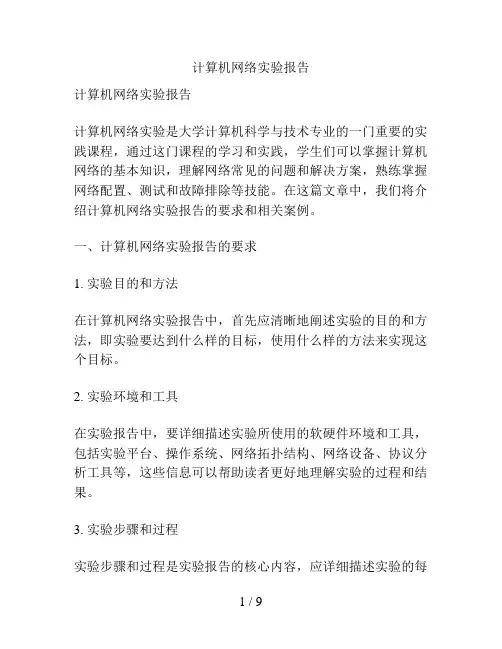
计算机网络实验报告计算机网络实验报告计算机网络实验是大学计算机科学与技术专业的一门重要的实践课程,通过这门课程的学习和实践,学生们可以掌握计算机网络的基本知识,理解网络常见的问题和解决方案,熟练掌握网络配置、测试和故障排除等技能。
在这篇文章中,我们将介绍计算机网络实验报告的要求和相关案例。
一、计算机网络实验报告的要求1. 实验目的和方法在计算机网络实验报告中,首先应清晰地阐述实验的目的和方法,即实验要达到什么样的目标,使用什么样的方法来实现这个目标。
2. 实验环境和工具在实验报告中,要详细描述实验所使用的软硬件环境和工具,包括实验平台、操作系统、网络拓扑结构、网络设备、协议分析工具等,这些信息可以帮助读者更好地理解实验的过程和结果。
3. 实验步骤和过程实验步骤和过程是实验报告的核心内容,应详细描述实验的每一个步骤和过程,包括实验前的准备工作、实验中的操作流程、实验的成功与失败情况等。
4. 实验结果和分析实验结果和分析是实验报告的重要组成部分,应对实验结果进行分析和总结,分析实验中遇到的问题和解决方案,总结实验的收获和不足之处。
5. 实验总结和建议在实验报告的最后,应进行实验总结和建议,总结实验的目的、过程和结果,提出对实验的改进建议和未来拓展的方向。
二、计算机网络实验报告案例1. 实验名称:网络文件传输实验实验目的:学习FTP、HTTP协议,掌握文件传输的基本原理和方法。
实验环境:Windows 7/10,FileZilla等软件。
实验步骤:1)安装FileZilla软件。
2)配置本地站点和FTP服务器,连接FTP服务器。
3)上传和下载文件,记录传输速度和流量。
4)进行HTTP文件下载实验,观察文件下载的过程和数据传输情况。
实验结果和分析:我们成功地完成了FTP和HTTP文件传输实验,对文件传输的原理和方法有了更深入的认识。
同时,我们也发现了文件传输的安全问题,并提出了数据加密的建议,以保护文件传输的安全。
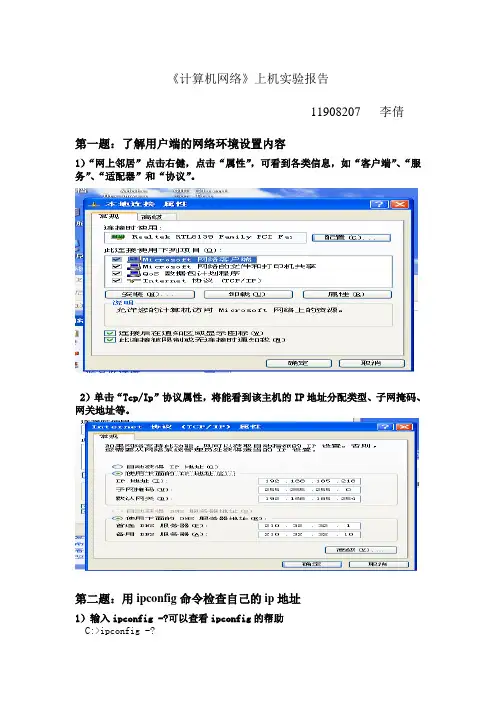
《计算机网络》上机实验报告11908207 李倩第一题:了解用户端的网络环境设置内容1)“网上邻居”点击右健,点击“属性”,可看到各类信息,如“客户端”、“服务”、“适配器”和“协议”。
2)单击“Tcp/Ip”协议属性,将能看到该主机的IP地址分配类型、子网掩码、网关地址等。
第二题:用ipconfig命令检查自己的ip地址1)输入ipconfig -?可以查看ipconfig的帮助C:>ipconfig -?2)输入ipconfig可以查看每一台网络设备接口的描述、IP地址、子网掩码(Subnet mask)、网关C:>ipconfig3)输入ipconfig –all 可以查看计算机的主机名,每一台网络设备接口的描述、硬件地址(MAC地址)、IP地址、子网掩码(Subnet mask)、网关(default gateway)、DNS服务器(DNS Server)等C:>ipconfig /all第三题:用ping、tracert等命令检查邻近同学的主机的连通情况;再访问两个校园网外就近的站点和远处的站点,观察响应时间和传输速率,将浏览结果作一简要记录PING命令是windows、linux下最常用的网络工具,它用来检查要到达的目标IP 地址并记录结果,显示目标是否响应以及接收答复所需的时间。
1)输入ping /?命令,可以查看ping命令的帮助C:\>ping -?2)通过输入ping 站点,可以测试到达站点的联通性(一些站点为了安全,对ICMP包不予回应,所以测试未必可达),从返回结果可以看出本机与所ping 站点之间的RRT,TTL。
C:\>ping 192.168.0.111tracert这个命令是用来查找对方的路由的。
也就是说,从你这里出发,会经过哪些路由器,然后到达目的地的。
它能够检查你上网时数据到达目的主机过程中的传输路径,可以知道数据传输过程中是否存在路由器瓶颈。
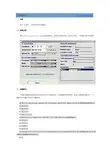
IP地址学习Top Previous Next 一、目标学习IP地址、子网划分和子网掩码。
二、实验内容利用IP Calculator工具,完成下面实验练习,熟悉IP地址分类、特殊IP地址、子网划分和子网掩码。
三、实验练习:下面的问题将帮助你评价你在本章中学习到的内容。
仔细阅读所有的选项,因为正确答案可能多于1个。
选择每个问题中所有的正确答案。
1) What is the network address for the address 96.2.3.16 (地址9 6.2.3.16的网络地址是什么)?A. 96.2.0.0B. 96.2.3.0C. 96.0.0.0D. Can 't tell2) What class of address is 190.233.27.13 (190.233.27.13是何类地址)?A. Class AB. Class BC. Class CD. Class D3) How many bits are in the default subnet mask for the address 219.25.23.56 (在地址219.25.23.56的默认子网掩码中有多少位)?A. 8B. 16C. 24D. 324) How many hosts are supported by a Class C network address, without subnetting (C类网络地址在没有子网的情况下支持多少个主机)?A. 254B. 65,000C. 255D. 16,0005) What is the default mask for a Class B network (B类网络的默认掩码是什么)?A. 255.0.0.0B. 255.255.255.0C. 255.255.0.0.D. 255.225.0.06) Approximately how many unique networks are possible with a Class B address (使用B类地址大约可以有多少个不相同的网络)?A. 254B. 16KC. 65KD. 2M7) What is the decimal value of the binary number 11 0 0 1 0 11 (二进制数11 0 0 1 0 11的十进制值是多少)?A. 203B. 171C. 207D. 1938) What is the binary value of the decimal number 219 (十进制数219的二进制值是多少)?A. 111 0 1 0 11B. 01011101C. 111 0 1 0 11D. 11 0 11 0 119) Subnet bits are added to_ _ _ _ _ _ _ _ _ _ to segment the network into subnets (子网位加入到____________以将网络划分为子网)?A. The network addressB. The default subnet maskC. The host addressD. The subnet ID10) If eight bits were allocated to subnetting with a Class B address, how many subnets would be possible (如果在B类地址中,将8位分配给子网,则有多少可能的子网)?A. 62B. 256C. 254D. 16K11) Given the subnet mask 255.255.240 on a Class A address, how many bits are allocated tosubnetting (在A类地址上给定了子网掩码255.255.240,则有多少位分配给子网)?A. 4B. 5C. 9D. 1212) If the subnet mask for the network 150.25.0.0 is 255.255.224.0, which of these is a valid host address (如果网络150.25.0.0的子网掩码是255.255.224.0,下面的哪一个是合法的主机地址)?A. 150.25.0.27B. 150.25.30.23C. 150.25.40.24D. 150.25.224.3013) What is the first subnet ID for the network 25.0.0.0 with a subnet mask of 255.192.0.0(带有子网掩码255.192.0.0的网络25.0.0.0的第一个子网I D是什么)?A. 25.192.0.0B. 25.64.0.0C. 25.128.0.0D. 25.192.64.014) What is the maximum number of subnet bits possible with a Class C address? (在C类地址下,子网位可能的最多数目是多少? )A. 6B. 8C. 14D. 1215) Given a subnet mask of 255.255.240, which of these addresses is not a valid host address(在给定子网掩码255.255.240的情况下,这些地址中的哪一个不是合法的主机地址)?A. 150.150.37.2B. 150.150.16.2C. 150.150.8.12D. 150.150.49.1516) How many hosts per subnet are possible with a Class B address, if five bits are added to the default mask for subnetting (在B类地址中,每个子网有多少可用的主机,如果在默认掩码后加入了5位,以进行子网划分)?A. 510B. 512C. 1022D. 204617) If you were issued a Class C address, and needed to divide the network into seven subnets, with up to 15 hosts in each subnet, what subnet mask would you use (如果你遇到了一个C类地址,并且需要将网络划分为7个子网,每个子网有1 5个主机,则将使用哪个子网掩码)?A. 255.255.255.224B. 255.255.224C. 255.255.255.240D. None of the AboveIP设置Top Previous Next 一、目标学习IP地址、子网划分和子网掩码。
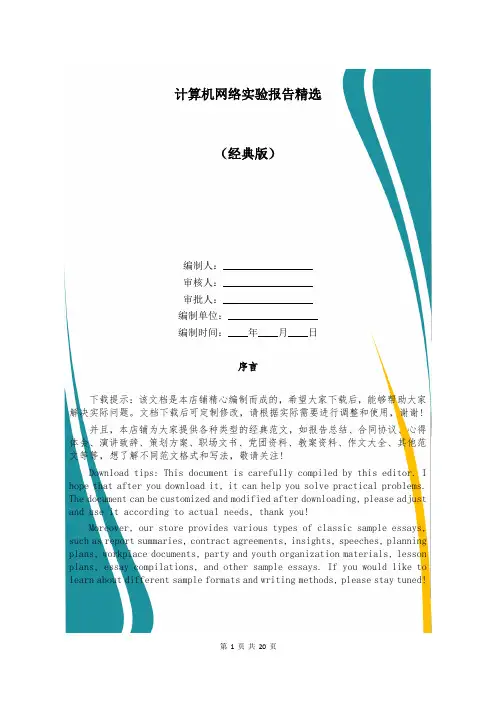
计算机网络实验报告精选(经典版)编制人:__________________审核人:__________________审批人:__________________编制单位:__________________编制时间:____年____月____日序言下载提示:该文档是本店铺精心编制而成的,希望大家下载后,能够帮助大家解决实际问题。
文档下载后可定制修改,请根据实际需要进行调整和使用,谢谢!并且,本店铺为大家提供各种类型的经典范文,如报告总结、合同协议、心得体会、演讲致辞、策划方案、职场文书、党团资料、教案资料、作文大全、其他范文等等,想了解不同范文格式和写法,敬请关注!Download tips: This document is carefully compiled by this editor. I hope that after you download it, it can help you solve practical problems. The document can be customized and modified after downloading, please adjust and use it according to actual needs, thank you!Moreover, our store provides various types of classic sample essays, such as report summaries, contract agreements, insights, speeches, planning plans, workplace documents, party and youth organization materials, lesson plans, essay compilations, and other sample essays. If you would like to learn about different sample formats and writing methods, please stay tuned!计算机网络实验报告精选随着社会不断地进步,报告使用的频率越来越高,报告具有语言陈述性的特点。
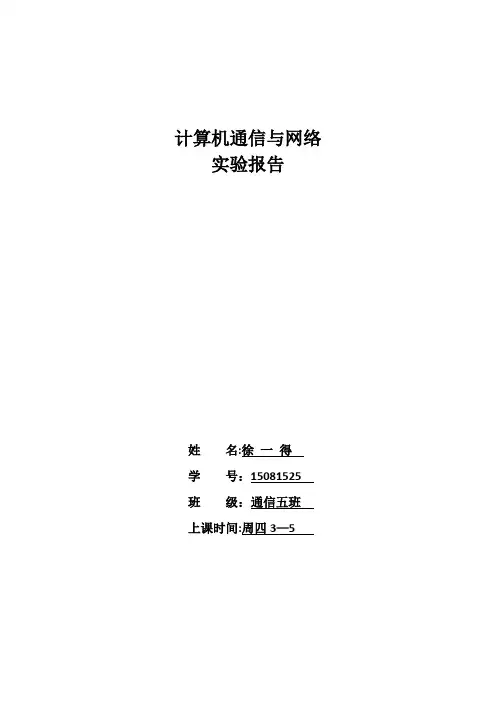
计算机通信与网络实验报告姓名:徐一得学号:15081525班级:通信五班上课时间:周四3—5实验名称:TCP/IP Configuration一、实验目的(1) To learn TCP/IP configuration。
(2) To learn the basic command of dos。
二、实验内容与要求1. Click Start and then click Run。
Type the command or cmd and then press Enter。
2。
At the DOS prompt,type NET HELP and press Enter。
You should see something like the screen below:The command you are interested in is the View command。
To obtain information about it, type NET HELP VIEW, and press Enter。
3. What is the purpose of NET VIEW:The NET VIEW command shows the names of the machines present on your network。
Lists the names of machines on the left,in column labelled “Server name” and another columns labelled “Remark"4. List the machines after you have typed NET VIEW from the command promptHDUSEC-01, HDUSEC-02,HDUSEC-03,……,HDUSEC-48Close the DOS window by typing EXIT on the command line and then press Enter, or by clicking the Close button in the upper right corner of the window。
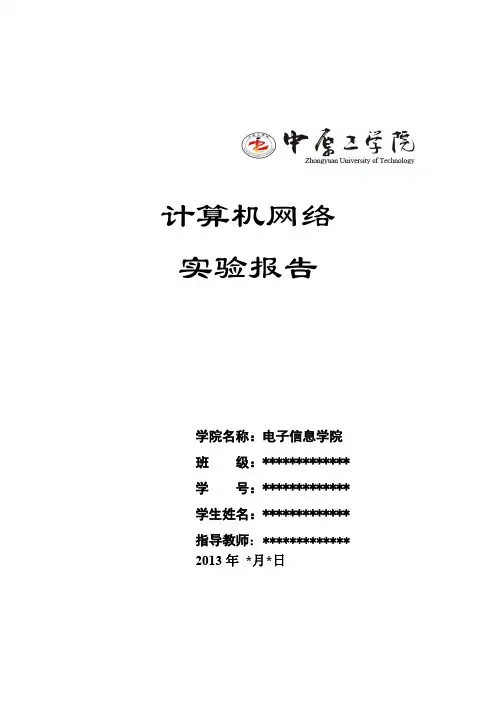
计算机网络实验报告学院名称:电子信息学院班级:*************学号:*************学生姓名:*************指导教师: *************2013年*月*日实验二组建WINDOWS环境下的对等网并共享资源一、实验目的1、利用网络设备,学生自己组成局域网,培养学生的动手能力。
2、掌握基本的网络参数的配置,学会使用基本的测试命令来检测网络的配置情况。
3、掌握对等网环境下软硬件共享的设置和使用方法。
4、了解一些安全访问选项的设置和取消操作。
二、实验属性验证性实验。
三、实验仪器设备及器材实验要求有若干台安装Windows XP的计算机,每台计算机都要安装网卡。
D-link DES-1024R+交换机两台,直通线、交叉线若干。
四、实验要求1、预习报告中需解决以下问题:(1)掌握TCP/IP的基本配置过程(2)了解交换机的工作特性(3)注意ping命令的使用方法及参数以及结果显示中各参数表示的含义。
(4)掌握对等网环境下软硬件共享的设置和使用方法。
2、试验中正确使用仪器设备,独立操作。
3、试验后按规定要求写出实验报告。
五、实验原理1、网卡的作用计算机与外界局域网的连接是通过主机箱内插入一块网络接口板的。
网络接口板又称为通信适配器(adapter)或网络接口卡NIC (Network Interface Card),或“网卡”。
网卡的重要功能是进行串行/并行转换,对数据进行缓存,实现以太网协议等。
2、交换机的作用交换式集线器常称为以太网交换机(switch)或第二层交换机,它实质上就是一个多端口的网桥,可见交换机工作在数据链路层。
交换机能同时连通许多对的端口,使每一对相互通信的主机都能像独占通信媒体那样,进行无碰撞地传输数据,因此它是独享信道的通信设备。
3、对等网的建立主要是为了实现计算机的资源的共享。
文件夹共享名称可与本地文件夹名称相同,也可以不同。
Windows XP提供3种访问权限类型。
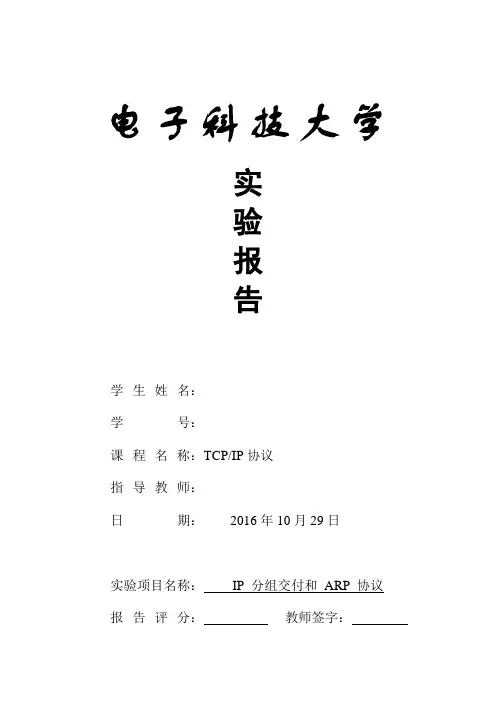
电子科技大学实验报告学生姓名:学号:课程名称:TCP/IP协议指导教师:日期:2016年10月29日实验项目名称:IP 分组交付和ARP 协议报告评分:教师签字:一、实验原理IP 子网中使用一个32 比特的掩码来标识一个IP 地址的网络/子网部分和主机部分。
将IP 地址和掩码进行“位与”运算后可以得到该IP 地址所在IP 子网的子网地址,结合掩码中0 比特个数可以确定该IP 子网的IP 地址空间范围。
根据IP 地址所在IP 子网的子网地址及其掩码,可以判断这些IP 地址是否属于同一个IP 子网。
IP 地址空间中定义了一些特殊地址:网络/子网地址:标识一个IP 网络或子网。
直接广播地址:表示该分组应由特定网络上的所有主机接收和处理。
受限广播地址:表示该分组应由源所在网络或子网上的所有主机接收和处理。
本网络上本主机地址:表示主机自己。
环回地址:用来测试机器的协议软件。
IP 分组被交付到最终目的地有两种不同的交付方式:直接交付和间接交付。
交付时首先通过路由选择技术确定交付方式:如果IP 分组的目的与交付者在同一个IP 网络上,就直接交付该分组至目的站点;如果IP 分组的目的与交付者不在同一个IP 网络上,就间接交付该分组至下一个路由器(即下一跳站点)。
在以太网上,IP 分组是封装在以太帧中发送的,因此发送时除了要有接收站的IP 地址(IP 分组中的目的IP 地址)外,还需要接收站的MAC 地址(以太网帧中的目的MAC 地址)。
ARP 协议(RFC 826)实现了IP 地址(逻辑地址)到MAC 地址(物理地址)的动态映射,并将所获得的映射存放在ARP 高速缓存表中。
不同的交付方法将导致不同的ARP 解析操作,获取不同的目的物理地址。
直接交付时,交付者直接将IP 分组交付给该分组的目的站点,因此交付者使用ARP 协议找出IP 分组中目的IP 地址对应的物理地址。
间接交付时,交付者需要将IP 分组交付给下一跳站点,而不是该IP 分组的目的端,因此交付者使用ARP 协议找出下一跳站点IP 地址对应的物理地址。
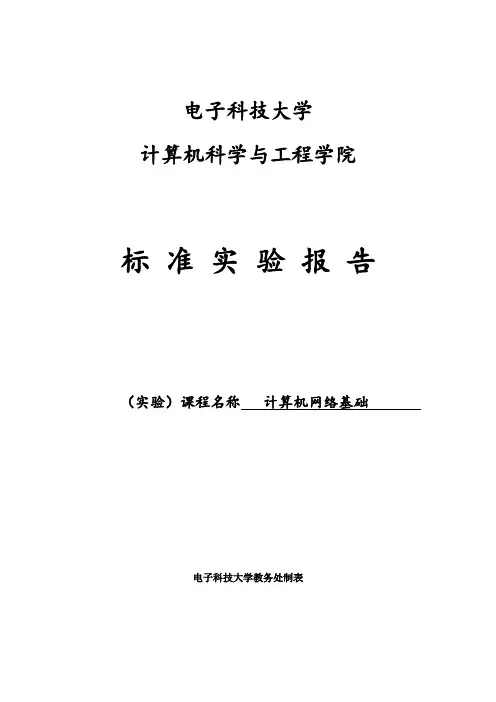
电子科技大学计算机科学与工程学院标准实验报告(实验)课程名称计算机网络基础电子科技大学教务处制表电子科技大学实验报告一、实验项目名称:交换机和路由器的基本配置二、实验目的:理解和掌握交换机和路由器的工作原理;掌握交换机和路由器命令行各种操作模式的区别;能够使用各种帮助信息,以及用命令进行基本的配置。
三、实验内容:假设是某公司新进的网管,公司要求你熟悉网络产品。
首先要求你登录交换机或路由器,了解并掌握交换机和路由器的命令行操作,以及如何使用一些基本命令对设备进行配置,包括交换机和路由器的设备名、登录时的描述信息、端口参数的基本配置,以及设备运行状态的查看。
四、实验环境:交换机console方式连接图路由器console方式连接图五、实验设备交换机1台、路由器1台、计算机1台。
六、实验原理:交换机和路由器(以下简称设备)的管理方式基本分为两种:带内管理和带外管理。
通过设备的Console口管理设备属于带外管理,不占用设备的网络接口,其特点是需要使用配置线缆,近距离配置。
第一次配置交换机或路由器时必须利用Console端口进行配置。
交换机或路由器的命令行操作模式,主要包括:用户模式、特权模式、全局配置模式、端口模式等几种。
●用户模式:进入设备后得到的第一个操作模式,该模式下可以简单查看设备的软、硬件版本信息,并进行简单的测试。
用户模式提示符为switch>或router>●特权模式:由用户模式进入的下一级模式,该模式下可以对设备的配置文件进行管理,查看设备的配置信息,进行网络的测试和调试等。
特权模式提示符为switch#或router#●全局配置模式:属于特权模式的下一级模式(子模式),该模式下可以配置设备的全局性参数(如设备名、登录信息等)。
在该模式下可以进入下一级的配置模式,对设备的具体功能进行配置。
全局配置模式提示符为switch(config)#或router(config)#●端口配置模式:属于全局配置模式的下一级模式(子模式),该模式下可以对交换机或路由器的网络端口进行参数配置。
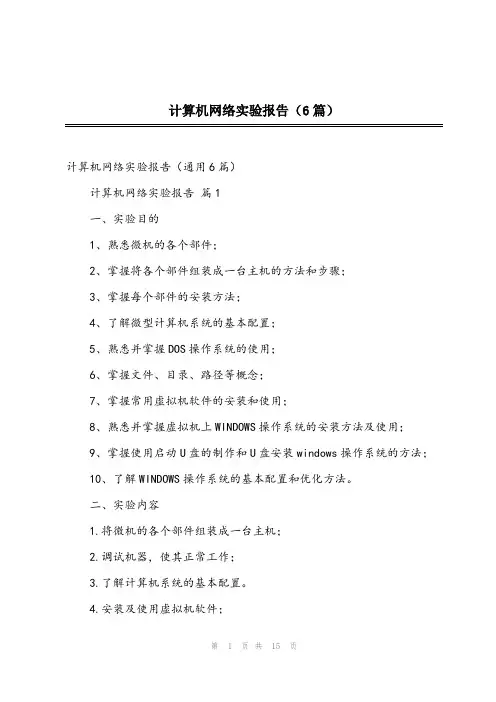
计算机网络实验报告(6篇)计算机网络实验报告(通用6篇)计算机网络实验报告篇1一、实验目的1、熟悉微机的各个部件;2、掌握将各个部件组装成一台主机的方法和步骤;3、掌握每个部件的安装方法;4、了解微型计算机系统的基本配置;5、熟悉并掌握DOS操作系统的使用;6、掌握文件、目录、路径等概念;7、掌握常用虚拟机软件的安装和使用;8、熟悉并掌握虚拟机上WINDOWS操作系统的安装方法及使用;9、掌握使用启动U盘的制作和U盘安装windows操作系统的方法;10、了解WINDOWS操作系统的基本配置和优化方法。
二、实验内容1.将微机的各个部件组装成一台主机;2.调试机器,使其正常工作;3.了解计算机系统的基本配置。
4.安装及使用虚拟机软件;5.安装WINDOWS7操作系统;6.常用DOS命令的使用;7.学会制作启动U盘和使用方法;8.WINDOWS7的基本操作;9.操作系统的基本设置和优化。
三、实验步骤(参照实验指导书上的内容,结合实验过程中做的具体内容,完成此项内容的撰写)四、思考与总结(写实验的心得体会等)计算机网络实验报告篇2windows平台逻辑层数据恢复一、实验目的:通过运用软件R-Studio_5.0和winhe_对误格式化的硬盘或者其他设备进行数据恢复,通过实验了解windows平台逻辑层误格式化数据恢复原理,能够深入理解并掌握数据恢复软件的使用方法,并能熟练运用这些软件对存储设备设备进行数据恢复。
二、实验要求:运用软件R-Studio_5.0和winhe_对电脑磁盘或者自己的U盘中的删除的数据文件进行恢复,对各种文件进行多次尝试,音频文件、系统文件、文档文件等,对简单删除和格式化的磁盘文件分别恢复,并检查和验证恢复结果,分析两个软件的数据恢复功能差异与优势,进一步熟悉存储介质数据修复和恢复方法及过程,提高自身的对存储介质逻辑层恢复技能。
三、实验环境和设备:(1)Windows _P 或Windows 20__ Professional操作系统。
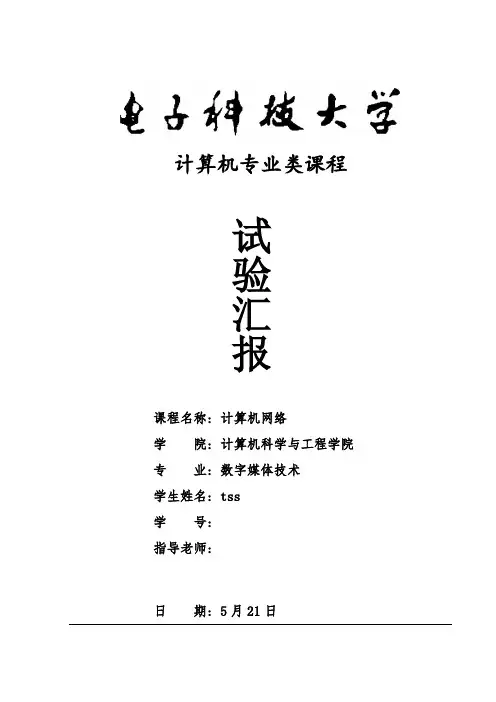
计算机专业类课程试验汇报课程名称: 计算机网络学院: 计算机科学与工程学院专业: 数字媒体技术学生姓名: tss学号:指导老师:日期: 5月21日电子科技大学实验报告试验一一、试验名称: 交换机和路由器基础配置二、试验课时: 1三、试验内容和目:了解和掌握交换机和路由器工作原理; 掌握交换机和路由器命令行多种操作模式区分; 能够使用多种帮助信息, 以及用命令进行基础配置。
四、试验原理:交换机和路由器(以下简称设备)管理方法基础分为两种: 带内管理和带外管理。
经过设备Console口管理设备属于带外管理, 不占用设备网络接口, 其特点是需要使用配置线缆, 近距离配置。
第一次配置交换机或路由器时必需利用Console端口进行配置。
交换机或路由器命令行操作模式, 关键包含: 用户模式、特权模式、全局配置模式、端口模式等多个。
此次试验学习多个模式之间切换, 以及路由器与交换机基础配置。
五、试验器材(设备、元器件)Cisco网络设备模拟器六、试验步骤:交换机配置第一步: 交换机各个操作模式直接切换使用enable进入特权模式, configure terminal进入配置模式第二步: 交换机命令行界面基础功效使用?能够输出在目前模式下可能命令第三步: 配置交换机名称和每日提醒信息使用banner motd $, 能够设置交换机进入时提醒语言。
经过$结束信息第四步: 配置接口状态第五步: 查看交换机系统和配置信息第六步: 保留配置Copy running-cofig startup-config 将现有配置保留到开启配置里Write memory , write 写入配置到nvram内路由器配置第一步: 配置路由器接口并查看接口配置进入config模式, interface fastEthernet 0/1进入接口配置, ip address 192.168.1.1 255.255.255.0配置好接口上子网第二步: 显示路由表信息在特权模式下输入show ip route七、试验数据及结果分析: (删去无用默认部分, 留下配置部分)交换机running-configSW-1#show running-configBuilding configuration...Current configuration : 1143 bytes!version 12.1!hostname SW-1!spanning-tree mode pvst!interface FastEthernet0/1description "this is a accessable port!!!" duplex halfspeed 10!interface Vlan1no ip addressshutdown!banner motd ^CWelcome to SW-1!!!!!!!^C!line con 0!line vty 0 4loginline vty 5 15login! !end路由器running-configRouter#show running-config Building configuration...Current configuration : 419 bytes!version 12.2!hostname Router!ip cefno ipv6 cef!interface FastEthernet0/0ip address 192.168.1.1 255.255.255.0 duplex autospeed auto!ip classless!ip flow-export version 9!line con 0!line aux 0!line vty 0 4login!end八、试验结论、心得体会和改善提议:第一次操作真正路由器, 与之前在家用路由器上玩openwrt, dd-wrt, padavan之类系统完全不一样。
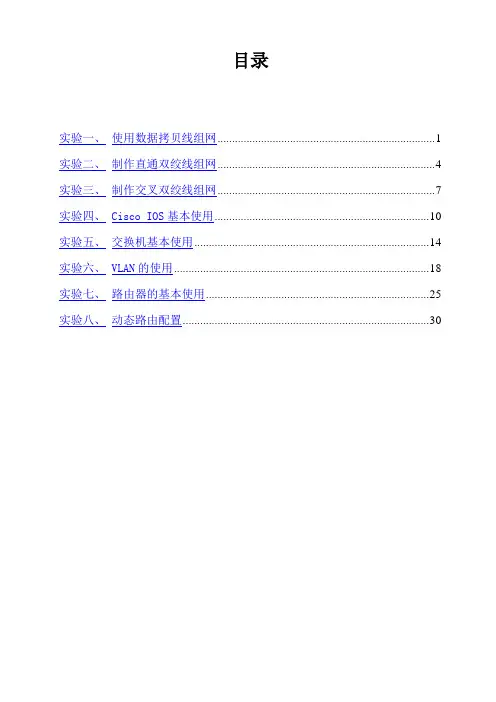
目录实验一、使用数据拷贝线组网 (1)实验二、制作直通双绞线组网 (4)实验三、制作交叉双绞线组网 (7)实验四、Cisco IOS基本使用 (10)实验五、交换机基本使用 (14)实验六、VLAN的使用 (18)实验七、路由器的基本使用 (25)实验八、动态路由配置 (30)实验一、使用数据拷贝线组网实验一使用数据拷贝线组网实验台号:实验时间:实验小组号:成员及本次实验分工:实验目的:学会使用并行电缆(数据拷贝线)实现双机通信和资源共享。
使用直接电缆实现两台PC机之间的通信。
实验环境说明:硬件:2台计算机、2-3根并行电缆软件:Windows XP操作系统实验过程及步骤(可另附页、使用网络拓扑图等辅助说明):(1)、使用并行电缆将两台PC机,进行物理互连;(2)、分别在两台PC机上的网上邻居中创建一个新连接。
按照新建连接向导的指示来做。
首先网络连接类型选为“设置高级连接”;然后其中作为服务器的那台PC机创建为“接受传入的连接”,作为客户机的则创建为“直接连接到其他计算机的连接”,并让此计算机担任“来宾”的角色。
接下去根据向导直至完成创建新连接。
(3)、测试两机的可通用性。
创建好连接之后可以用ping命令测试一下两台机器之间是否已经连通。
(4)、连接创建成功之后,客户机可以找到并登入到服务器,就可以实现对服务器上的资源的共享了。
当然在此之前作为服务器的主机还需要将文件夹属性设置成为可共享的。
测试数据线连接以后Ping对方说明能够Ping通在一台PC上设置共享,然后在另外一台PC上查看共享截图如下:说明通过数据拷贝线成功地连接了两台PC,实现了他们之间的通信。
实验总结(遇到的问题及解决办法、体会):刚开始配置客户机的时候出了点问题。
需要输入对方计算机的名字,我们却输入了服务器上的计算机用户的帐号,所以一直没有连接成功。
后来终于发现了这个问题。
配置也就顺利了。
实验器材、工具领用及归还负责人:验收人:实验执笔人:实验记录人:报告协助人:实验报告完成时间:小组成员签名:指导教师评议成绩评定:指导教师签名:实验二、制作直通双绞线组网实验二制作直通双绞线组网实验台号: 实验时间: 实验小组号:成员及本次 实验分工: 实验目的:1. 了解双绞线的相关知识;2. 学会制作直通双绞线;3. 掌握用双绞线实现集线器和计算机之间的互连。
计算机专业类课程实验报告课程名称:计算机网络学院:计算机科学与工程学院专业:数字媒体技术学生姓名:tss学号:20150605010指导教师:日期:2017年5月21日电子科技大学实验报告实验一一、实验名称:交换机和路由器的基本配置二、实验学时:1三、实验内容和目的:理解和掌握交换机和路由器的工作原理;掌握交换机和路由器命令行各种操作模式的区别;能够使用各种帮助信息,以及用命令进行基本的配置。
四、实验原理:交换机和路由器(以下简称设备)的管理方式基本分为两种:带内管理和带外管理。
通过设备的Console口管理设备属于带外管理,不占用设备的网络接口,其特点是需要使用配置线缆,近距离配置。
第一次配置交换机或路由器时必须利用Console端口进行配置。
交换机或路由器的命令行操作模式,主要包括:用户模式、特权模式、全局配置模式、端口模式等几种。
本次实验学习多种模式之间的切换,以及路由器与交换机的基本配置。
五、实验器材(设备、元器件)Cisco网络设备模拟器六、实验步骤:交换机的配置第一步:交换机各个操作模式直接的切换使用enable进入特权模式,configure terminal进入配置模式第二步:交换机命令行界面基本功能使用?可以输出在当前模式下可能的命令第三步:配置交换机的名称和每日提示信息使用banner motd $,可以设置交换机进入时的提示语言。
通过$结束信息第四步:配置接口状态第五步:查看交换机的系统和配置信息第六步:保存配置Copy running-cofig startup-config 将现有的配置保存到启动配置里Write memory , write 写入配置到nvram内路由器的配置第一步:配置路由器的接口并查看接口配置进入config模式,interface fastEthernet 0/1进入接口配置,ip address 192.168.1.1 255.255.255.0配置好接口上的子网第二步:显示路由表的信息在特权模式下输入show ip route七、实验数据及结果分析:(删去无用的默认部分,留下配置部分)交换机running-configSW-1#show running-configBuilding configuration...Current configuration : 1143 bytes!version 12.1!hostname SW-1!spanning-tree mode pvst!interface FastEthernet0/1description "this is a accessable port!!!" duplex halfspeed 10!interface Vlan1no ip addressshutdown!banner motd ^CWelcome to SW-1!!!!!!!^C!line con 0!line vty 0 4loginline vty 5 15login! !end路由器running-configRouter#show running-config Building configuration...Current configuration : 419 bytes!version 12.2!hostname Router!ip cefno ipv6 cef!interface FastEthernet0/0ip address 192.168.1.1 255.255.255.0 duplex autospeed auto!ip classless!ip flow-export version 9!line con 0!line aux 0!line vty 0 4login!end八、实验结论、心得体会和改进建议:第一次操作真正的路由器,与之前在家用路由器上玩openwrt,dd-wrt,padavan之类的系统完全不一样。
学 生 实 验 报 告(理工类)课程名称:计算机网络与通信 专业班级:学生学号: 学生姓名:所属院部: 信息技术学院 指导教师: 不填20 ——20 学年 第 学期实验报告书写要求实验报告原则上要求学生手写,要求书写工整。
若因课程特点需打印的,要遵照以下字体、字号、间距等的具体要求。
纸张一律采用A4的纸张。
实验报告书写说明实验报告中一至四项内容为必填项,包括实验目的和要求;实验仪器和设备;实验内容与过程;实验结果与分析。
各院部可根据学科特点和实验具体要求增加项目。
填写注意事项(1)细致观察,及时、准确、如实记录。
(2)准确说明,层次清晰。
(3)尽量采用专用术语来说明事物。
(4)外文、符号、公式要准确,应使用统一规定的名词和符号。
(5)应独立完成实验报告的书写,严禁抄袭、复印,一经发现,以零分论处。
实验报告批改说明实验报告的批改要及时、认真、仔细,一律用红色笔批改。
实验报告的批改成绩采用百分制,具体评分标准由各院部自行制定。
实验报告装订要求实验批改完毕后,任课老师将每门课程的每个实验项目的实验报告以自然班为单位、按学号升序排列,装订成册,并附上一份该门课程的实验大纲。
实验项目名称:双绞线的制作实验学时:同组学生姓名:实验地点:实验日期:实验成绩:批改教师:批改时间:禁止抄袭,如发现相同的,均记为零分。
说明:红色部分仅为说明,看完后,红色部分删除一、实验目的和要求1、了解LAN中常用的几种传输介质、连接器的性能及各自特点。
2、学习并掌握双绞线、同轴电缆网线的制作和掌握网线制作工具,电缆测试仪的使用。
3、掌握T568A和T568B两种线序标准,掌握双绞线的直通线和交叉线制作过程及应用5、独立制作一根合格的双绞线网线,进行连通性测试,并给出本实验的实验报告。
二、实验仪器和设备5类双绞线,RJ-45水晶头,剥线钳、压线钳、双绞线测线器。
三、实验内容与过程1、选定制作网线的类型,列出制作双绞线选用的线序标准2、独立制作一根合格的双绞线,并写出制作的过程3、测试双绞线的连通性。
计算机网络实验报告计算机网络实验报告1一、实验目的1. 掌握几种常用的网络命令,通过使用这些命令能检测常见网络故障2. 理解各命令的含义,并能解释其显示内容的意义二、实验内容1. 运行 Windows 常用的网络命令,ipconfig、ping、netstat、nbtstat、arp、route、 net、tracert2. 利用子网掩码、实现子网的划分3. 了解 VRP 的各种视图及各视图下的常用命令三、实验原理、方法、手段该实验通过执行一些常用的网络命令,来了解网络的状况、性能,并对一些网络协议能更好的理解。
下面介绍一下实验中用到的网络命令:1. ipconfig 命令该命令显示IP 协议的具体配置信息,命令可以显示网络适配器的物理地址、主机的IP 地址、子网掩码以及默认网关等,还可以查看主机名、DNS 服务器、节点类型等相关信息。
2. ping 命令该命令用于测试网络联接状况以及信息发送和接收状况。
3. netstat 命令该命令用于检验网络连接情况,它可以显示当前正在活动的网络连接的详细信息。
4. nbtstat 命令该命令用于查看本地计算机或远程计算机上的NetBIOS 的统计数据,显示协议统计情况以及当前TCP/IP 的连接所使用NETBIOS 情况,运用NETBIOS,可以查看本地计算机或远程计算机上的NETBIOS 名字列表。
5. arp 命令使用ARP 命令,你能够查看本地计算机或另一台计算机的ARP 高速缓存中的当前内容,也可以用人工方式输入静态的网卡物理地址/IP 地址对,使用这种方式为缺省网关和本地服务器等常用主机进行这项操作,有助于减少网络上的信息量。
6. route 命令ROUTE 命令用于显示、人工添加和修改路由表项目。
7. net 命令net 命令是WIN 系列里面最有用的网络方面的命令之一,它不是一个命令,而是一组命令。
8. tracert 命令Tracert 使用很简单,只需要在tracert 后面跟一个IP 地址或URL,tracert 会在进行相应的域名转换的。
计算机网络实验报告计算机网络实验报告(通用19篇)在生活中,报告的使用频率呈上升趋势,报告包含标题、正文、结尾等。
我们应当如何写报告呢?以下是小编帮大家整理的计算机网络实验报告,欢迎大家借鉴与参考,希望对大家有所帮助。
计算机网络实验报告篇1一、实验目的1、掌握文件的复制、移动、删除;2、掌握文件的重命名、属性的设置;3、掌握文件的查找;4、掌握文件夹选项操作。
5、通过控制面板查看和修改主要输入输出设备的设置;6、查看和修改系统基本配置信息。
7、通过用户管理设置,使计算机为多人合用,同时管理员可以根据需要控制其它用户的操作权限;8、通过对计算机的环境设置,优化计算机的性能,加强用户的计算机安全意识,提高计算机病毒应对能力。
二、实验任务1、查找文件“notepad、exe”,在D盘上以自己的学号为名建立一个新的文件夹,在此文件夹内建一名为“记事本”的文件夹,将文件“notepad、exe”复制到“记事本”文件夹下面,属性修改为“只读”,然后在桌面上创建“notepad、exe”文件的快捷方式。
2、显示“我的文档”文件夹下所有文件的扩展名。
3、修改鼠标、显示器、输入法的设置。
4、显示系统硬件配置信息。
5、添加删除程序。
6、添加、删除用户,修改用户信息。
7、修改虚拟内存设置,优化计算机性能三、实验检查内容1、是否在E区建立以自己学号为名的文件夹2、是否在学号文件夹中创建名为“记事本”的文件夹3、是否将“notepad、exe”文件复制到“记事本”文件夹中4、“notepad、exe”文件的属性是否修改为“只读”5、是否在桌面上创建“notepad、exe”文件的快捷方式6、是否显示文件的扩展名7、修改鼠标处于“正常选择”状态的显示图形8、修改显示器的分辨率9、设置CTRL+SHIFT+1为某种中文输入法的热键10、设置Windows系统在“关闭程序”事件时的声音11、查找本机CPU的频率12、写出本机网络适配器的名称13、添加一个以自己学号为名的用户14、将虚拟内存设置到D区,最大值为1GB。
《计算机通信网络》实验报告姓名班级实验一网络基本概念及应用【实验目的】1.掌握网络的基本概念和术语。
2.熟练掌握电子邮件E-mail的使用。
3.了解Internet的发展过程,掌握获取Internet资源的方法。
熟练掌握Internet搜索引擎Google、Y ahoo等的使用。
【实验环境】Windows 操作系统的计算机,具备Internet环境。
【实验重点及难点】重点学习掌握E-mail的使用以及通过Internet获取资源的方法。
【实验内容】1、记录下局域网结构(1)画出局域网的网络拓扑结构示意图并详细标注各设备类型。
其中的方框代表诸如计算机和打印机之类的部件,并且用直线连接这些部件。
(2)在图表上用字母“S”标记服务器.用字母“W”标记工作站,用字母“P”标记打印机。
如不能确定其中的某个部件,就用字母“O”把它们标记为“其他”。
(3)记录下网络操作系统的类型和版本。
NetWare网络操作系统Windows2000网络操作系统UNIX网络操作系统Linux网络操作系统(4)记录下网络接口卡的类型光纤分布式数据接口。
5、记录下网络的协议。
TCP/IP2、在因特网上创建一个免费的E-mail帐号(以雅虎网站为例)(1)打开因特网浏览器(2)登录到,然后主页出现在屏幕上(3)选中“电邮”图标(4)仔细阅读“雅虎服务协议条款”,选定“接受条款并注册”(5)填写用户名、密码及其它用户信息,然后选择“提交”(6)如果出现“注册成功”信息,则表示创建成功,你的E-mail地址即为用户名@。
如果提示错误,则根据提示重新填写信息。
(7)(8)记录下你的电子邮件ID。
现在就可以在世界上任何地方使用你的Y ahoo电子邮件ID来收发由电子邮件服务提供商提供的电子邮件。
lidegao@(9)3、使用因特网百科全书(1)打开因持网浏览器(2)登录到(3)在搜索对话框中,输入Client,然后选中Go!。
则webopedia屏幕显示出client的定义则屏幕显示NIC(网络接口卡)的定义(5)从weboPedia中退出,并且关闭因特网浏览器实验二网络标准和OSI模型的理解【实验目的】1. 了解网络标准化组织。
通信工程专业综合实验计算机网络综合实验实验报告姓名:王启汉学号:10211199班级:通信1008指导教师:卢燕飞上课时间:周三下午第一节目录实验一:网络设备的基本操作 (1)一、实验内容: (1)二、实验设备: (1)三、实验连接图: (1)四、实验步骤: (1)五、路由配置及相关文件说明: (2)六、实验中遇到的问题以及解决方法: (3)七、思考题: (3)实验一:配置VLAN (4)一、实验内容: (4)二、实验设备: (4)三、实验连接图: (4)四、实验步骤: (4)五、路由配置及相关文件说明: (4)六、实验中遇到的问题及解决方法: (6)实验二、交换机端口安全技术 (6)一、实验内容: (6)二、实验设备: (6)三、实验连接图: (6)四、实验步骤: (7)五、路由配置及相关文件说明: (7)六、实验中遇到的问题及解决办法: (8)七、思考题: (8)实验一:实验准备 (9)一、实验内容: (9)二、实验设备: (9)三、实验连接图: (9)四、实验步骤: (10)五、路由配置及相关文件说明: (10)六、实验中遇到的问题及解决方法: (10)实验二:配置静态路由和动态路由 (11)一、实验内容: (11)二、实验设备: (11)三、实验连接图: (11)四、实验步骤: (11)五、路由配置及相关文件说明: (11)六、实验中遇到的问题及解决方法: (13)七、思考题: (13)第一次实验实验一:网络设备的基本操作一、实验内容:1、在计算机上实现对网络设备的Console口登陆管理;2、在计算机上使用Telnet终端登陆相关设备;3、掌握网络设备上操作系统及文件操作的基本操作命令使用;4、使用TFTP服务实现网络设备上文件的上传下载。
二、实验设备:实验设备见下表:三、实验连接图:如图所示:四、实验步骤:实验操作步骤按照课本P23-P33进行。
五、路由配置及相关文件说明:#version 5.20, Release 2104P09 //版本号#sysname Cond //将系统名称改为Cond#super password level 3 simple test //将系统级别设置为3,并使用明文密码test #domain default enable system //开启默认域#telnet server enable //开启telnet服务#dar p2p signature-file flash:/p2p_default.mtd#port-security enable //开启端口安全设置#vlan 1 //vlan1#domain systemaccess-limit disablestate activeidle-cut disableself-service-url disable#user-group system //用户组#local-user adminpassword cipher .]@USE=B,53Q=^Q`MAF4<1!!authorization-attribute level 3service-type telnetlocal-user Cond //用户名设置为Condpassword simple Cond //使用明文密码,密码为Condservice-type telnet // 使用telnet服务#interface Ethernet0/0port link-mode routeip address 192.168.0.1 255.255.255.0 //telnet路由器的以太网接口ip地址#load xml-configuration#load tr069-configuration#user-interface tty 12user-interface aux 0user-interface vty 0 4authentication-mode scheme#return六、实验中遇到的问题以及解决方法:1、在登录telnet服务时,只显示用户名却不显示密码,经询老师后,明白这是系统问题,并不是我们的设置问题,可以放心使用;2、修改时间后发现,桌面右下角的时间还是原来的时间。
计算机通信与网络实验报告姓名:徐一得学号:15081525班级:通信五班上课时间:周四3-5实验名称:Simulation on Performance of Data Link Control Protocols一、实验目的1.Realizing the principles of Data Link Control Protocols.eing the software called matalab to simulate thePerformance of Data Link Control Protocols.二.实验原理流量控制实际上是对发送方数据流量的控制,使其发送率不致超过接收方所能承受的能力。
这个过程需要通过某种反馈机制使发送方知道接收方是否能跟上发送方,也即需要有一些规则使得发送方知道在什么情况下可以接着发送下一帧,而在什么情况下必须暂停发送,以等待收到某种反馈信息后继续发送。
二、实验内容与要求Using the same assumptions that are used for Figure 7.13 in Appendix 7A,plot line utilization as a function of P, the probability that a single frame is inerror for the following error-control techniques:a. Stop-and-waitb. Go-back-N with w=7c. Go-back-N with w=127d. Selective reject with w=7e. Selective reject with w=127Do all of the preceding for the following values of a: 0.1, 1, 10, 100. Drawconclusions about which technique is appropriate for various ranges of a.三、实验程序与结果Project(1)a=0:0.1:1000;U=utilization(a,1); //when length of window is 1semilogx(a,U,'b'); //using function to depict linehold onU=utilization(a,7); //when length of window is 7semilogx(a,U,'k');hold onU=utilization(a,127); //when length of window is 127semilogx(a,U,'m');title('figure 7.12 slind-wind utilization as a function of a')ylabel('utilization')xlabel('a')text(0.7,0.5,'\leftarrow w=1'); //noting arrow toshow what the line is text(8,0.6,'\leftarrow w=7');text(130,0.8,'\leftarrow w=127');function U=utilization(a,w)U=1.*(w>=2*a+1)+w./(2*a+1).*(w<2*a+1);End //formula for utilization U=1/(1+2a)Project(2)a=0:0.1:1000;p=1/1000;U=stopandwait(a,p); //using the formula tocalculate the U semilogx(a,U,'r'); //using function to depict line hold onU=selective_reject(a,7,p); //using the formula tocalculate the Usemilogx(a,U,'g');hold onU=gobackn(a,7,p);semilogx(a,U,'b');hold onU=selective_reject(a,127,p);semilogx(a,U,'k');hold onU=gobackn(a,1277,p);semilogx(a,U,'y');title('figure 7.13 ARQ utilization as a function of a (P=10-3)')ylabel('utilization')xlabel('a')text(0.2,0.2,'stopwait\rightarrow ');text(0.23,0.7,'w=7 Go-back-N & \newline w=7 selective_reject\rightarrow w=7');text(10,0.8,'w=127\newline Go-back-N \rightarrow');text(110,0.7,'\leftarrow w=127');function U=stopandwait(a,p)U=(1-p)./(1+2*a); //U=(1-p)/(1+2a)endfunction U=selective_reject(a,w,p)U=(1-p).*(w>=2*a+1)+w.*(1-p)./(2*a+1).*(w<2*a+1);End //U=1-p when w>=2a+1U=W(1-p)/(2a+1) when w<2a+1function U=gobackn(a,w,p)U=(1-p)./(1+2.*a.*p).*(w>=2*a+1)+w.*(1-p)./(2.*a+1)./(1-p+w .*p).*(w<2*a+1); //U=(1-p)/(1+2p) when w>=2a+1U=w(1-p)/(2a+1)(1-p+wp) endProject(3)figureset (gcf,'position',[300,0,800,800],'color','w') //当前Figure对象的句柄值a=[0.1, 1,10,100];for i=1:4subplot(2,2,i)lab2_draw(a(i))title(stract('a=',num2str(a(i)))) // draw four differentlines endfunction lab2_draw //the formula todraw the first line p=0:0.1:1000;U=stopandwait(a,p);semilogx(a,U,'r');hold onU=selective_reject(a,7,p);semilogx(a,U,'g');hold onU=gobackn(a,7,p);semilogx(a,U,'b');hold onU=selective_reject(a,127,p);semilogx(a,U,'k');hold onU=gobackn(a,127,p);semilogx(a,U,'y');ylabel('utilization')xlabel('p')legend('stop-and-wait','Go-back-N with w=7','Go-back-N with w=127','selective_reject with w=7','selective_reject with w=127',3)end四、实验结果分析(1)This graph shows the maximum utilization achievable for window sizes of 1, 7 127.A window size of 1 corresponds to stop and wait, in which shows when after sending a frame , the sender have to wait an acknowledge to send anther frame. In this condition , when a>>the time of sending ,we can see it the utilization is very low. A window size of 7 is adequate for many application, as it has pretty big buffing area, which can increase the rate of utilization. A window size of 127 is adequate for larger values of a.(2)We have ignore errors in acknowledgement frames and ,in the case of go-back-N, errors in retransmitted frames other than the frame initially in error.as a result ,when a>>t ,the efficiency of selective-reject is most high.(3)(1)When a=0.1 or 1, W=7 or 127>> 2a+1, so the lines ofgo-back-N with n=7 and go-back-N with n=127 overlap,selective-reject with w=7 and selective-reject with w=127 also overlap.When a=10,则selective-reject with wand go-back-N both are 分段函数五、实验问题解答与体会Through the first net experiment, I realize the principles of Data LinkControl Protocols. Besides I write code to testify those principles, whichoffers me deep insight of those two methods. As for me confusion, I don’t know the error correction part of CRC an d how to modify the parity check to make more efficient.教师评语:图不够清晰成绩:A。